Assessing the Influence of Planting Dates on Sustainable Maize Production under Drought Stress Conditions
Abstract
:1. Introduction
2. Materials and Methods
2.1. Experimental Design
2.2. Measurement Indicators and Methods
2.3. Statistical Analysis
3. Results
3.1. Days to Tasseling (DTT), Days to Anthesis (DTA), and Days to Silking (DTS)
3.2. ASI (Anthesis–Silking Interval), Plant Height (PH), and Ear Height (EH)
3.3. Tassel Branch and Tassel Length
3.4. Leaf Length and Leaf Width
3.5. Grain Row Number and Single Ear Weight
3.6. Ear Length, Ear Diameter, and Ear Area
3.7. Bald Tip and Hole Percentage
3.8. Number of Grains per Ear, Grain Width, Grain Thickness, Grain Length, and Hundred-Grain Weight
4. Discussion
5. Conclusions
Author Contributions
Funding
Institutional Review Board Statement
Informed Consent Statement
Data Availability Statement
Acknowledgments
Conflicts of Interest
References
- Ceglar, A.; Toreti, A. Seasonal climate forecast can inform the European agricultural sector well in advance of harvesting. npj Clim. Atmos. Sci. 2021, 4, 42. [Google Scholar] [CrossRef]
- Ciais, P.; Reichstein, M.; Viovy, N.; Granier, A.; Ogee, J.; Allard, V.; Aubinet, M.; Buchmann, N.; Bernhofer, C.; Carrara, A.; et al. Europe-wide reduction in primary productivity caused by the heat and drought in 2003. Nature 2005, 437, 529–533. [Google Scholar] [CrossRef] [PubMed]
- Lesk, C.; Anderson, W.; Rigden, A.; Coast, O.; Jägermeyr, J.; McDermid, S.; Davis, K.F.; Konar, M. Compound heat and moisture extreme impacts on global crop yields under climate change. Nat. Rev. Earth Environ. 2022, 3, 872–889. [Google Scholar] [CrossRef]
- Hussain, H.A.; Saddam, H.; Abdul, K.; Umair, A.; Anjum, S.A.; Shengnan, M.; Longchang, W. Chilling and drought stresses in crop plants: Implications, cross talk, and potential management opportunities. Front. Plant Sci. 2018, 9, 393–414. [Google Scholar] [CrossRef] [PubMed]
- Ostmeyer, T.; Parker, N.; Jaenisch, B.; Alkotami, L.; Bustamante, C.; Jagadish, K.S. Impacts of heat, drought, and their interaction with nutrients on physiology, grain yield, and quality in field crops. Plant Physiol. Rep. 2020, 25, 549–568. [Google Scholar] [CrossRef]
- Li, Y.; Guan, K.; Peng, B.; Franz, T.E.; Wardlow, B.; Pan, M. Quantifying irrigation cooling benefits to maize yield in the US Midwest. Glob. Chang. Biol. 2020, 26, 3065–3078. [Google Scholar] [CrossRef] [PubMed]
- Christian, J.I.; Basara, J.B.; Hunt, E.D.; Otkin, J.A.; Xiao, X. Flash drought development and cascading impacts associated with the 2010 Russian heatwave. Environ. Res. Lett. 2020, 15, 094078. [Google Scholar] [CrossRef]
- Xia, J.; Chen, J.; She, D. Impacts and countermeasures of extreme drought in the Yangtze River Basin in 2022. J. Hydraul. Eng. 2022, 53, 1143–1153. [Google Scholar]
- Liu, X.; Yuan, X.; Ma, F.; Xia, J. The increasing risk of energy droughts for hydropower in the Yangtze River basin. J. Hydrol. 2023, 621, 129589. [Google Scholar] [CrossRef]
- Lesk, C.; Anderson, W. Decadal variability modulates trends in concurrent heat and drought over global croplands. Environ. Res. Lett. 2021, 16, 055024. [Google Scholar] [CrossRef]
- Cohen, I.; Zandalinas, S.I.; Huck, C.; Fritschi, F.B.; Mittler, R. Meta-analysis of drought and heat stress combination impact on crop yield and yield components. Physiol. Plant. 2021, 171, 66–76. [Google Scholar] [CrossRef]
- He, Y.; Fang, J.; Shi, P. Substantial increase of compound droughts and heatwaves in wheat growing seasons worldwide. Int. J. Climatol. 2022, 42, 5038–5054. [Google Scholar] [CrossRef]
- Zhang, Q.; Yao, Y.; Wang, Y.; Wang, S.; Wang, J.; Yang, J.; Wang, J.; Li, Y.; Shang, J.; Li, W. Characteristics of drought in southern china under climatic warming, the risk, and countermeasures for prevention and control. Theor. Appl. Climatol. 2018, 136, 1157–1173. [Google Scholar] [CrossRef]
- Ren, Y.; Yue, P.; Zhang, Q.; Liu, X. Influence of land surface aridification on regional monsoon precipitation in East Asian summer monsoon transition zone. Theor. Appl. Climatol. 2021, 144, 93–102. [Google Scholar] [CrossRef]
- Wu, T.; Li, B.; Lian, L.; Zhu, Y.; Chen, Y. Assessment of the combined risk of drought and high-temperature heat wave events in the North China Plain during summer. Remote Sens. 2022, 14, 4588. [Google Scholar] [CrossRef]
- Luan, X.; Bommarco, R.; Scaini, A.; Vico, G. Combined heat and drought suppress rainfed maize and soybean yields and modify irrigation benefits in the USA. Environ. Res. Lett. 2021, 16, 064023. [Google Scholar] [CrossRef]
- Ray, D.K.; Gerber, J.S.; Macdonald, G.K.; West, P.C. Climate variation explains a third of global crop yield variability. Nat. Commun. 2015, 6, 5989. [Google Scholar] [CrossRef] [PubMed]
- Widmann, C.M.A.M.; Widmann, M.; Bevacqua, E.; Loon, A.F.V.; Maraun, D.; Vrac, M. Soil moisture drought in Europe: A compound event of precipitation and potential evapotranspiration on multiple time scales. J. Hydrometeorol. 2018, 19, 1255–1271. [Google Scholar]
- Dikšaitytė, A.; Viršilė, A.; Žaltauskaitė, J.; Januškaitienė, I.; Praspaliauskas, M.; Pedišius, N. Do plants respond and recover from a combination of drought and heatwave in the same manner under adequate and deprived soil nutrient conditions? Plant Sci. 2020, 291, 110333. [Google Scholar] [CrossRef]
- Dash, A.P.; Lenka, D.; Tripathy, S.K.; Swain, D.; Lenka, D. Character association and path analysis of grain yield and its components in Maize (Zea mays L.) under heat stress. Int. J. Curr. Microbiol. Appl. Sci. 2020, 9, 2750–2758. [Google Scholar] [CrossRef]
- Yang, X.; Lu, M.; Wang, Y.; Wang, Y.; Liu, Z.; Chen, S. Response mechanism of plants to drought stress. Horticulturae 2021, 7, 50. [Google Scholar] [CrossRef]
- Noor, J.J.; Vinayan, M.T.; Umar, S.; Devi, P.; Iqbal, M.; Seetharam, K.; Zaidi, P.H. Morpho-physiological traits associated with heat stress tolerance in tropical maize (Zea mays L.) at reproductive stage. Aust. J. Crop Sci. 2019, 13, 536–545. [Google Scholar] [CrossRef]
- Yan, Z.; Liu, D.; Jia, X.; Yang, Q.; Chen, Y.; Dong, P.; Wang, Q. Maize Tassel Development, Physiological Traits and Yield Under Heat and Drought Stress During Flowering Stage. Sci. Agric. Sin. 2021, 54, 3592–3608. [Google Scholar]
- Brás, T.A.; Seixas, J.; Carvalhais, N.; Jgermeyr, J. Severity of drought and heatwave crop losses tripled over the last five decades in Europe. Environ. Res. Lett. 2021, 16, 065012. [Google Scholar] [CrossRef]
- Leng, G. Maize yield loss risk under droughts in observations and crop models in the United States. Environ. Res. 2021, 16, 024016. [Google Scholar] [CrossRef]
- Li, E.; Zhao, J.; Pullens, J.W.M.; Yang, X. The compound effects of drought and high-temperature stresses will be the main constraints on maize yield in Northeast China. Sci. Total Environ. 2022, 812, 152461. [Google Scholar] [CrossRef] [PubMed]
- Harrison, L.; Michaelsen, J.; Funk, C.; Husak, G. Effects of temperature changes on maize production in Mozambique. Clim. Res. 2011, 46, 211–222. [Google Scholar] [CrossRef]
- Ahmad, I.; Wajid, S.A.; Ahmad, A.; Cheema, M.J.M.; Judge, J. Assessing the impact of thermo-temporal changes on the productivity of spring maize under semi-arid environment. Int. J. Agric. Biol. 2018, 20, 2203–2210. [Google Scholar]
- Ottman, M.J.; Kimball, B.A.; White, J.W.; Wall, G.W. Wheat growth response to increased temperature from varied planting dates and supplemental infrared heating. Agron. J. 2012, 104, 7–16. [Google Scholar] [CrossRef]
- Wheeler, T.; Von Braun, J. Climate change impacts on global food security. Science 2013, 341, 508–513. [Google Scholar] [CrossRef] [PubMed]
- Dias, A.S.; Lidon, F.C. Evaluation of grain filling rate and duration in bread and durum wheat, under heat stress after anthesis. J. Agron. Crop Sci. 2009, 195, 137–147. [Google Scholar] [CrossRef]
- Wang, J.; Wang, E.; Luo, Q.; Kirby, M. Modelling the sensitivity of wheat growth and water balance to climate change in Southeast Australia. Clim. Chang. 2009, 96, 79–96. [Google Scholar] [CrossRef]
- Asseng, S.; Foster, I.A.N.; Turner, N.C. The impact of temperature variability on wheat yields. Glob. Chang. Biol. 2011, 17, 997–1012. [Google Scholar] [CrossRef]
- Kharazmshahi, H.A.; Zahedi, H.; Alipour, A. Effects of sowing date on yield and yield components in sweet maize (Zea mays L.) hybrids. Biol. Forum Int. J. 2015, 7, 835–840. [Google Scholar]
- Hussain, N.; Zaman, Q.; Nadeem, M.A.; Aziz, A. Response of maize varieties under agroecological conditions of Dera Ismail Khan. J. Agric. Res. 2010, 48, 59–63. [Google Scholar]
- Shah, A.; Akmal, M.; Asim, M.; Farhatullah; Raziuddin; Rafi, A. Maize growth and yield in Peshawar under changing climate. Pak. J. Bot. 2012, 44, 1933–1938. [Google Scholar]
- Hassaan, M.A. Response of some yellow maize hybrids (Zea mays L.) to sowing date under Toshka conditions. J. Plant Produc. 2018, 9, 509–514. [Google Scholar] [CrossRef]
- Abaza, A.S.D. Effect of Irrigation Water Levels, Flter Mud Cake Application and Sowing DATES on maize Production under Tushka Conditions. Ph.D. Thesis, Faculty of Agriculture/Assiut University, El Fateh, Egypt, 2021. [Google Scholar]
- Buriro, M.; Bhutto, T.A.; Gandahi, A.W.; Kumbhar, I.A.; Shar, M.U. Effect of sowing dates on growth, yield and grain quality of hybrid maize. J. Basic Appl. Sci. 2015, 11, 553–558. [Google Scholar] [CrossRef]
- Ali, S.; Inamullah; Jan, A.; Din, M.; Habibullah, M. Yield response of maize (Zea mays L.) hybrids sown on various dates during kharif in Peshawar-Pakistan. J. Environ. Earth Sci. 2015, 5, 13–17. [Google Scholar]
- Giunta, F.; Prunddu, G.; Motzu, R. Radiation interception and biomass and nitrogen. Field Crops Res. 2009, 110, 76–84. [Google Scholar] [CrossRef]
- Jing, Q.; Bingwv, W.; Yong, M. A study on comprehensive evaluation of maize hybrids. J. Jilin Agric. Univ. 2003, 25, 139–142. [Google Scholar]
- Atta, Y.I. Improving growth, yield and water productivity of some maize cultivars by new planting method. Egypt J. Appl. Sci. 2007, 22, 1–16. [Google Scholar]
- Rekaby, S.A.; Eissa, M.A.; Hegab, S.A.; Ragheb, H.M. Effect of water stress on maize grown under drip irrigation system. Assiut J. Agric. Sci. 2017, 48, 1110–1486. [Google Scholar]
- Wang, F.; Xue, J.; Xie, R.; Ming, B.; Wang, K.; Hou, P.; Zhang, L.; Li, S. Assessing growth and water productivity for drip-irrigated maize under high plant density in arid to semi-humid climates. Agriculture 2022, 12, 97. [Google Scholar] [CrossRef]
- De Micco, V.; Aronne, G.R. Morpho-anatomical traits for plant adaptation to drought. In Plant Responses to Drought Stress; Aroca, R., Ed.; Springer: Berlin/Heidelberg, Germany, 2012. [Google Scholar] [CrossRef]
- Kulczycki, G.; Sacała, E.; Chohura, P.; Załuska, J. Maize and wheat response to drought stress under varied sulphur fertilisation. Agronomy 2022, 12, 1076. [Google Scholar] [CrossRef]
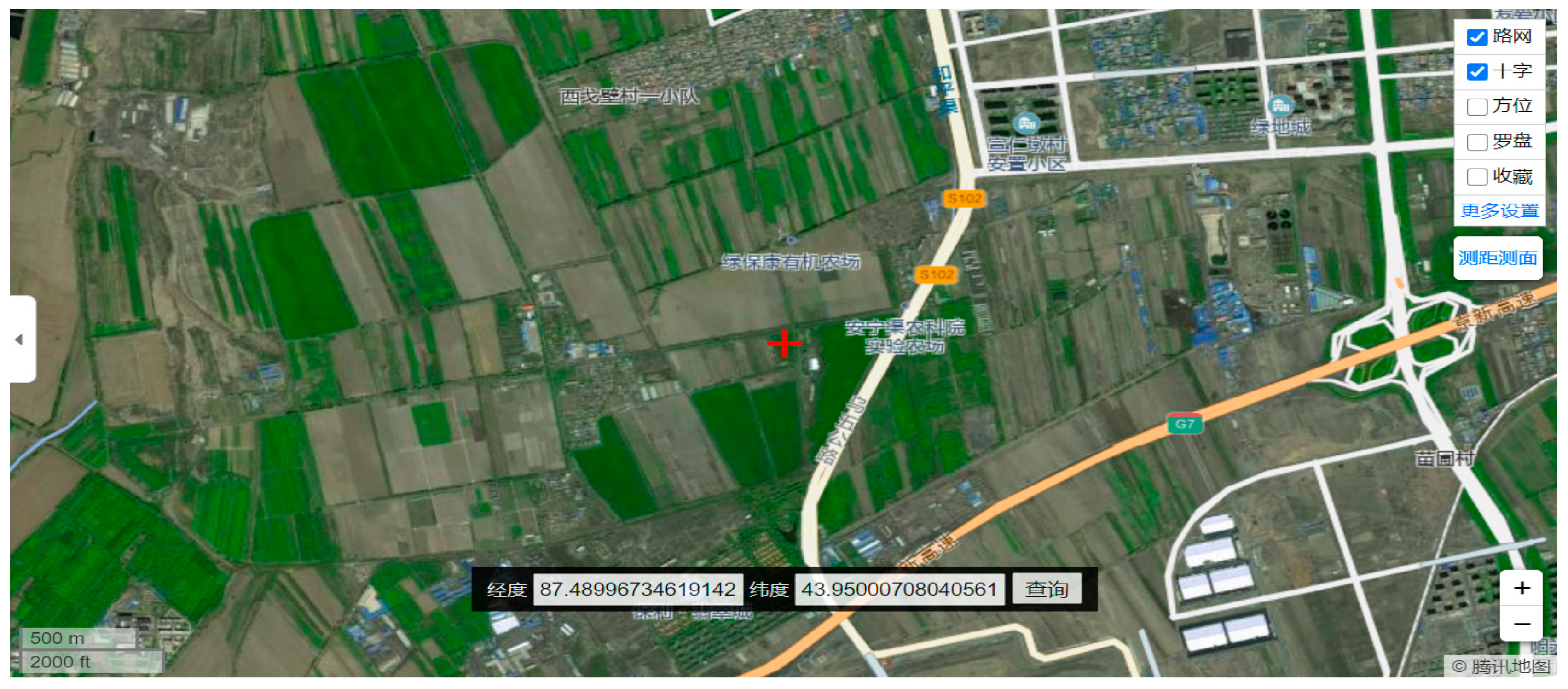





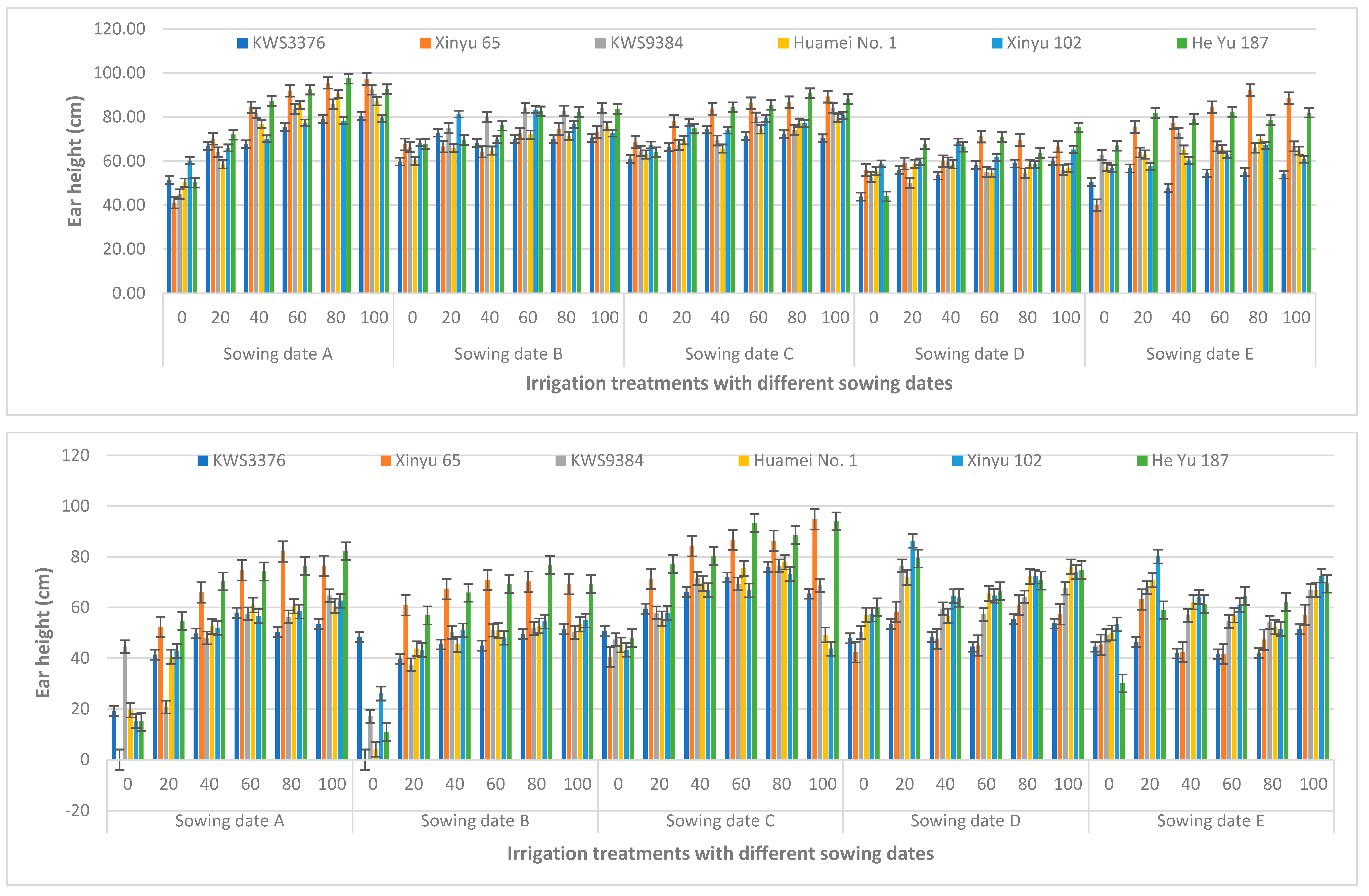
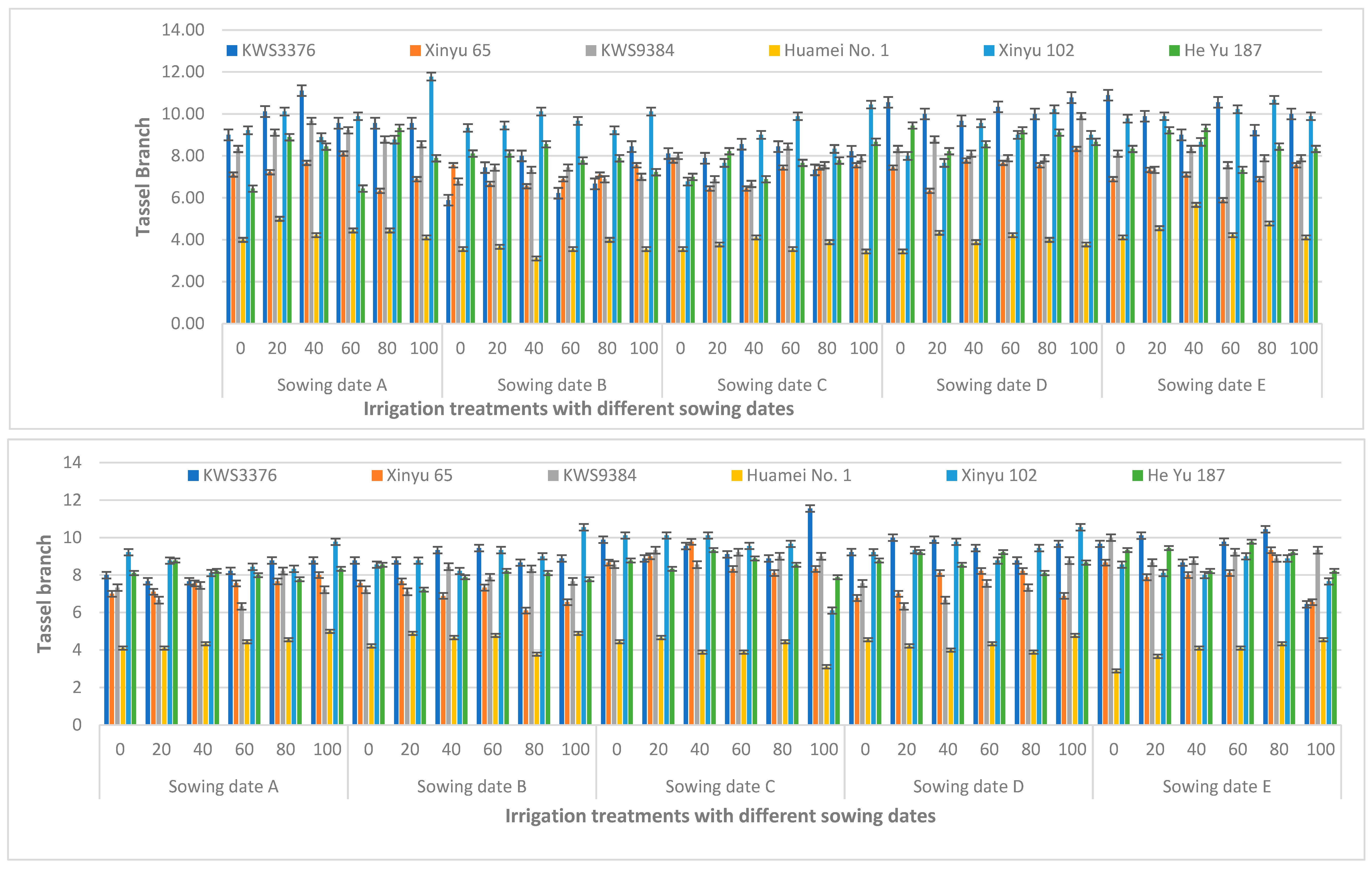


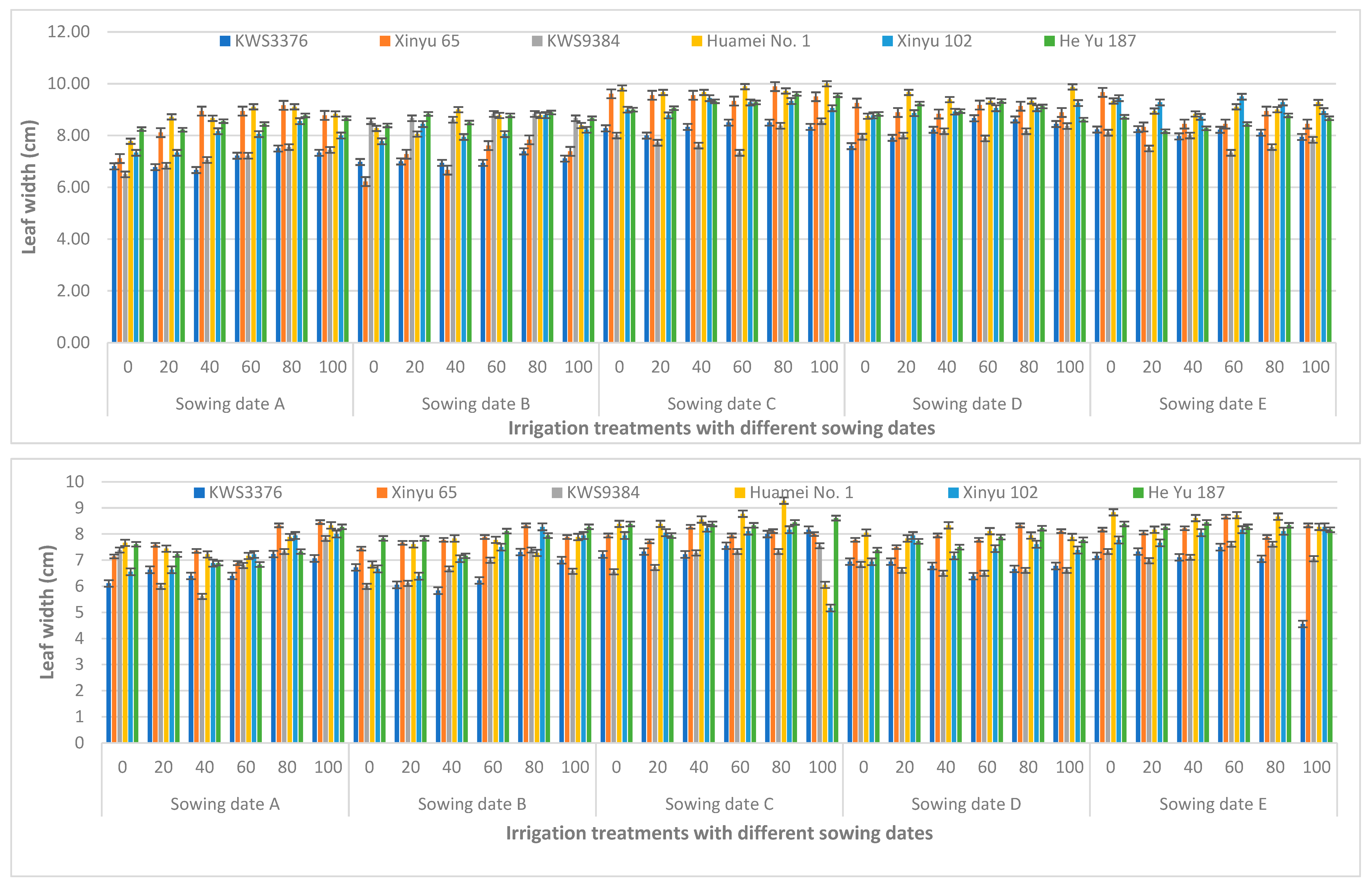

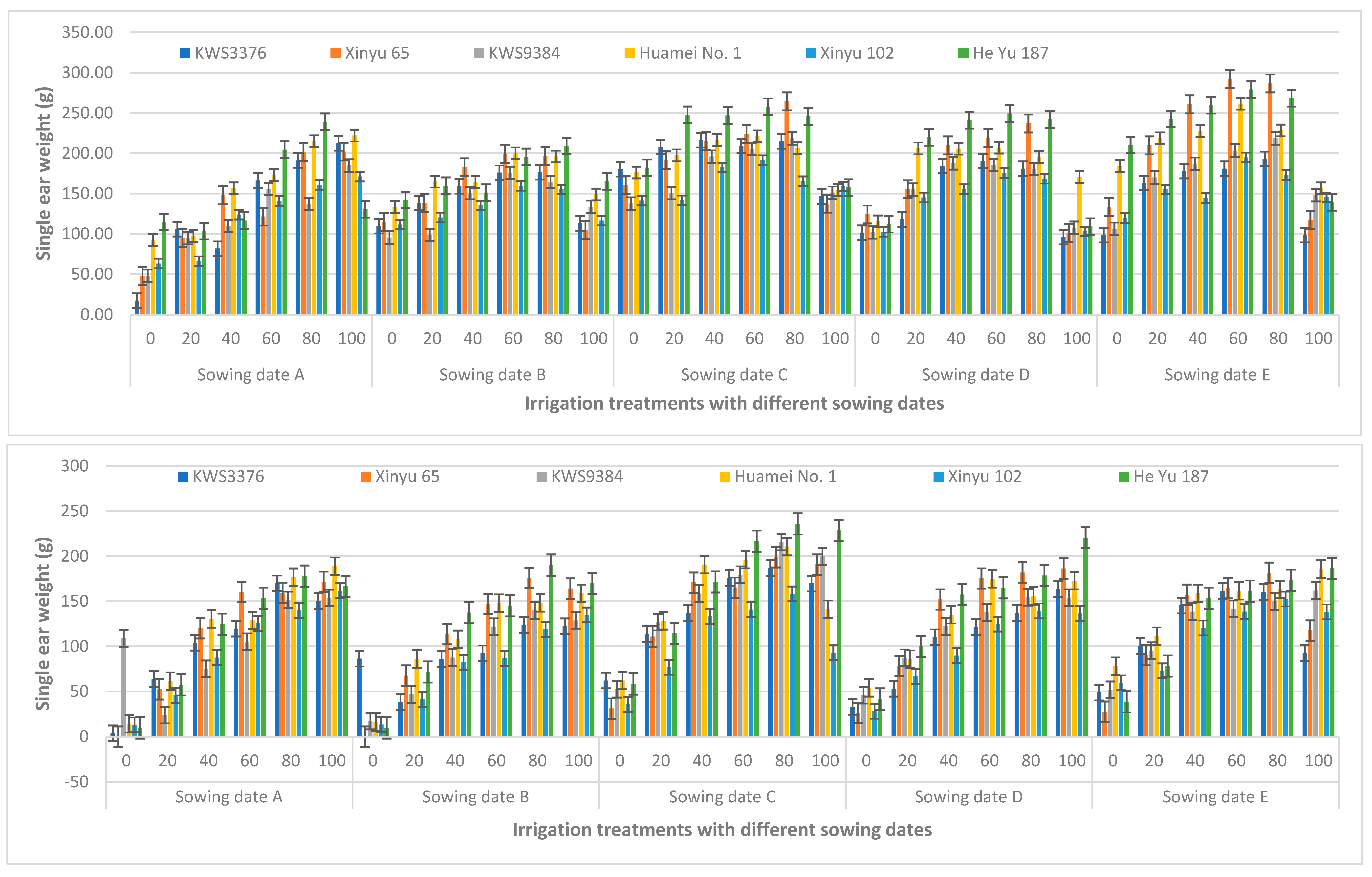



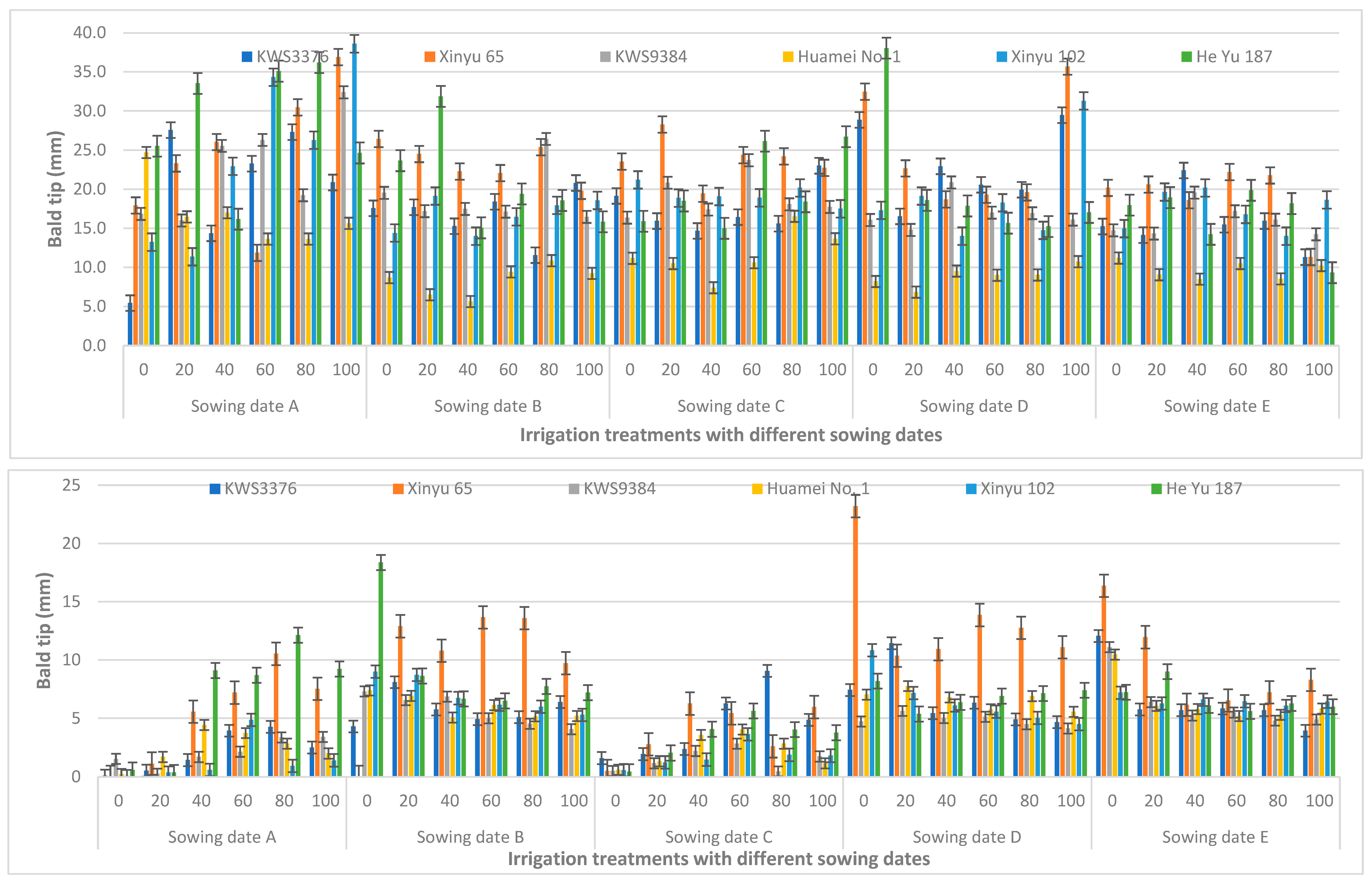


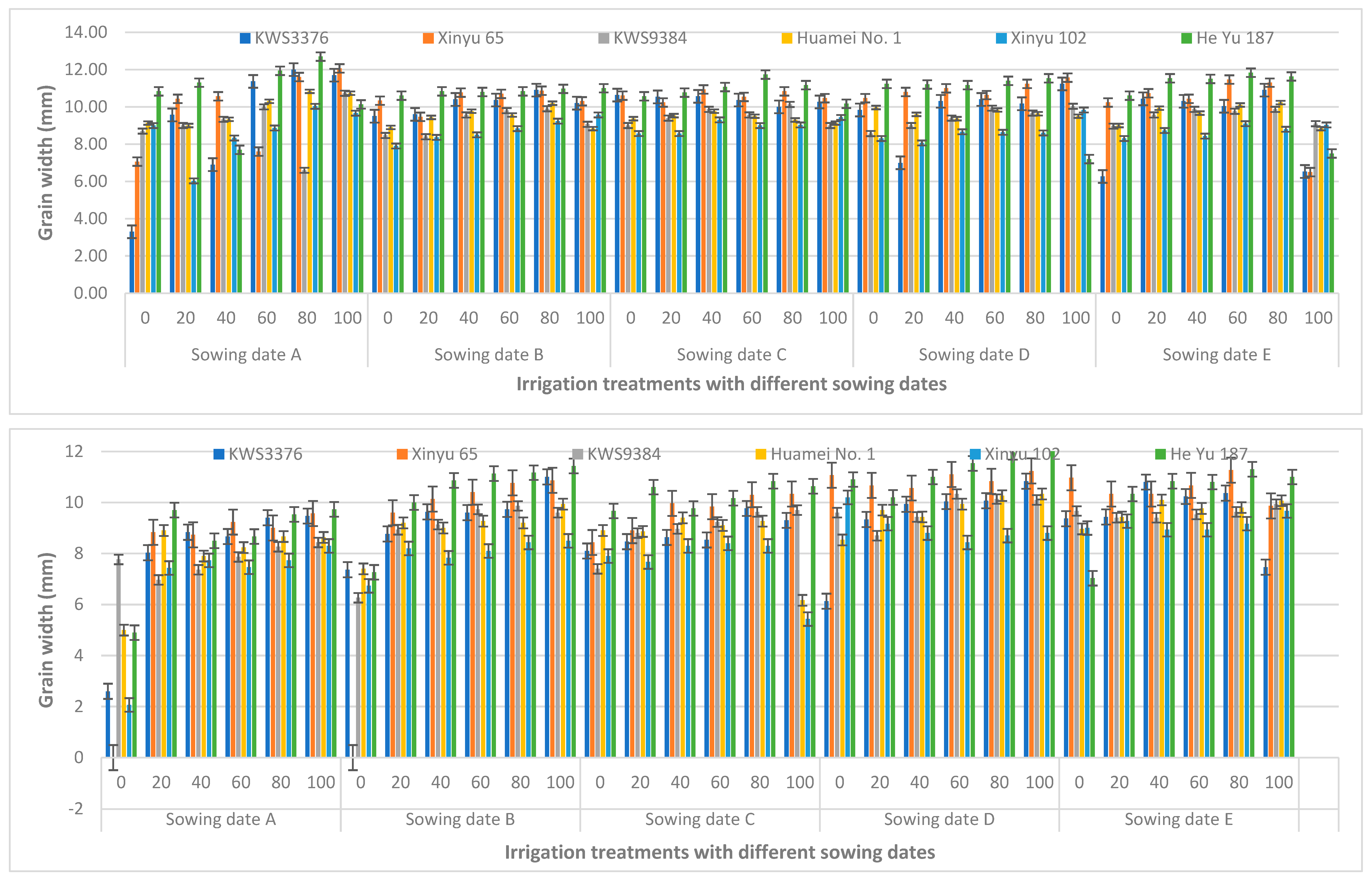


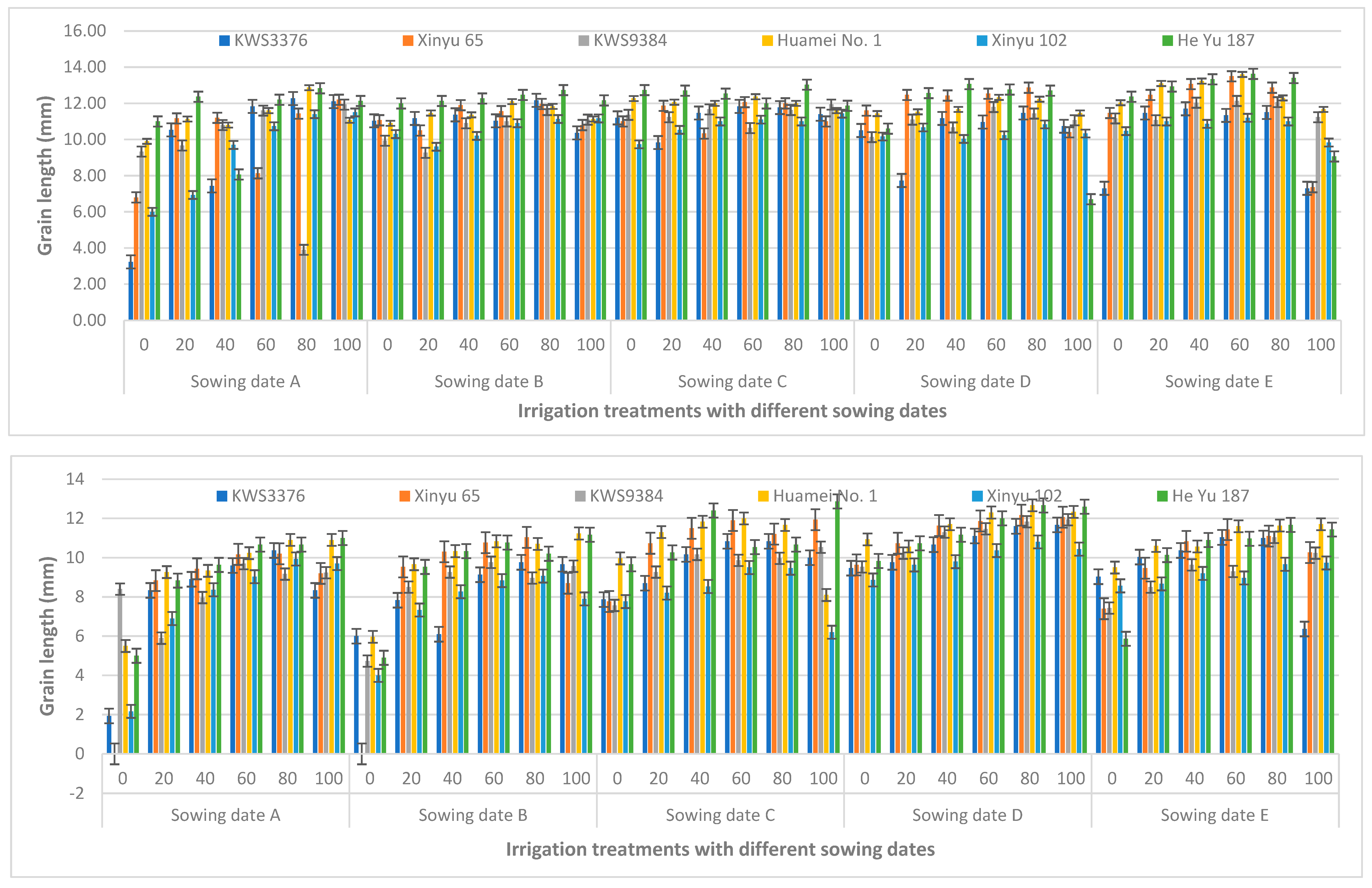
| Sowing Date Deal with | Moisture Deal with | Watering Time | |||||||
|---|---|---|---|---|---|---|---|---|---|
| Emergence | Jointing Stage | Small Trumpet Mouth | Big Trumpet Mouth | Flowering Period | Early Grouting | Grouting | Grouting End | ||
| A | Water 1 | 675 | 675 | 675 | 675 | 675 | 675 | 675 | 675 |
| Water 2 | 675 | 540 | 540 | 540 | 540 | 540 | 540 | 540 | |
| Water 3 | 675 | 405 | 405 | 405 | 405 | 405 | 405 | 405 | |
| Water 4 | 675 | 270 | 270 | 270 | 270 | 270 | 270 | 270 | |
| Water 5 | 675 | 135 | 135 | 135 | 135 | 135 | 135 | 135 | |
| Water 6 | 675 | 0 | 0 | 0 | 0 | 0 | 0 | 0 | |
| B | Water 1 | 675 | 675 | 675 | 675 | 675 | 675 | 675 | 675 |
| Water 2 | 675 | 540 | 540 | 540 | 540 | 540 | 540 | 540 | |
| Water 3 | 675 | 405 | 405 | 405 | 405 | 405 | 405 | 405 | |
| Water 4 | 675 | 270 | 270 | 270 | 270 | 270 | 270 | 270 | |
| Water 5 | 675 | 135 | 135 | 135 | 135 | 135 | 135 | 135 | |
| Water 6 | 675 | 0 | 0 | 0 | 0 | 0 | 0 | 0 | |
| C | Water 1 | 675 | 675 | 675 | 675 | 675 | 675 | 675 | 675 |
| Water 2 | 675 | 540 | 540 | 540 | 540 | 540 | 540 | 540 | |
| Water 3 | 675 | 405 | 405 | 405 | 405 | 405 | 405 | 405 | |
| Water 4 | 675 | 270 | 270 | 270 | 270 | 270 | 270 | 270 | |
| Water 5 | 675 | 135 | 135 | 135 | 135 | 135 | 135 | 135 | |
| Water 6 | 675 | 0 | 0 | 0 | 0 | 0 | 0 | 0 | |
| D | Water 1 | 675 | 675 | 675 | 675 | 675 | 675 | 675 | 675 |
| Water 2 | 675 | 540 | 540 | 540 | 540 | 540 | 540 | 540 | |
| Water 3 | 675 | 405 | 405 | 405 | 405 | 405 | 405 | 405 | |
| Water 4 | 675 | 270 | 270 | 270 | 270 | 270 | 270 | 270 | |
| Water 5 | 675 | 135 | 135 | 135 | 135 | 135 | 135 | 135 | |
| Water 6 | 675 | 0 | 0 | 0 | 0 | 0 | 0 | 0 | |
| E | Water 1 | 675 | 675 | 675 | 675 | 675 | 675 | 675 | 675 |
| Water 2 | 675 | 540 | 540 | 540 | 540 | 540 | 540 | 540 | |
| Water 3 | 675 | 405 | 405 | 405 | 405 | 405 | 405 | 405 | |
| Water 4 | 675 | 270 | 270 | 270 | 270 | 270 | 270 | 270 | |
| Water 5 | 675 | 135 | 135 | 135 | 135 | 135 | 135 | 135 | |
| Water 6 | 675 | 0 | 0 | 0 | 0 | 0 | 0 | 0 | |
| Seeding Treatment | Sowing Period and Temperature | Expected Flowering Period and Temperature | Expected Harvest Period and Temperature | |||||||||
|---|---|---|---|---|---|---|---|---|---|---|---|---|
| Sowing Period | Smallest | Average | Maximum | Flowering Period | Smallest | Average | Maximum | Harvest Period | Smallest | Average | Maximum | |
| Broadcast date 1 | April 21 | 4.3 | 11.9 | 19.5 | June 27 | 18.1 | 25.7 | 33.3 | September 4 | 12.9 | 20.5 | 28.1 |
| Broadcast period 2 | April 26 | 5.7 | 13.3 | 20.9 | July 1 | 18.4 | 26.0 | 33.6 | September 7th | 12.3 | 19.9 | 27.5 |
| Sowing season 3 | May 6th | 8.5 | 16.1 | 23.7 | July 7 | 18.7 | 26.3 | 33.9 | September 15th | 10.4 | 18.0 | 25.6 |
| Sowing season 4 | May 16th | 11.1 | 18.7 | 26.3 | July 14th | 18.9 | 26.5 | 34.1 | September 27th | 7.2 | 14.8 | 22.4 |
| Sowing season 5 | May 26 | 13.3 | 20.9 | 28.5 | July 21 | 18.8 | 26.4 | 34.0 | October 13 | 2.5 | 10.1 | 17.7 |
| May 31 | 14.4 | 22.0 | 29.6 | July 25 | 18.6 | 26.2 | 33.8 | Can’t mature | ||||
| Sowing Dates | Soil Depth (2021) | |||||
|---|---|---|---|---|---|---|
| 100 mm | 200 mm | 300 mm | 400 mm | 600 mm | 1000 mm | |
| A | 15.619 | 18.504 | 24.158 | 34.554 | 34.254 | 40.212 |
| B | 16.438 | 19.785 | 24.173 | 27.685 | 33.385 | 33.123 |
| C | 11.669 | 16.108 | 20.781 | 31.985 | 32.8 | 20.646 |
| D | 13.062 | 16.4 | 25.535 | 28.15 | 38.104 | 34.612 |
| E | 13.569 | 19.954 | 15.446 | 19.742 | 36.838 | 36.381 |
| Soil Depth (2022) | ||||||
| A | 6.48 | 4.0067 | 9.3933 | 11.287 | 22.22 | 22.207 |
| B | 5.9533 | 2.3933 | 13.88 | 17.333 | 16.24 | 31.107 |
| C | 9.96 | 3.98 | 16.013 | 16.767 | 23.52 | 27.273 |
| D | 4.48 | 2.12 | 7.5533 | 21.573 | 35.787 | 37.96 |
| E | 10.38 | 4.48 | 8.5733 | 10.773 | 35.72 | 40.773 |
| Parameters | Var | Sow | Var × Sow | Var × Irri | Sow × Irri | Var × Sow × Irri |
|---|---|---|---|---|---|---|
| Days to tasseling | *** | ** | ** | ** | *** | ** |
| Days to anthesis | ** | ** | *** | *** | ** | ** |
| Days to silking | *** | *** | ** | *** | *** | ** |
| ASI | ||||||
| Plant height | ** | ** | ** | *** | *** | NA |
| Ear height | *** | ** | ** | ** | *** | ** |
| Tassel branch | ** | ** | *** | *** | ** | ** |
| Tassel length | ** | ** | *** | *** | ** | ** |
| Leaf length | *** | *** | ** | *** | *** | ** |
| Leaf width | ** | ** | *** | *** | ** | ** |
| Grain row number | *** | ** | ** | ** | *** | ** |
| Single ear weight | ** | ** | *** | *** | ** | ** |
| Ear length | ** | ** | *** | *** | ** | ** |
| Ear diameter | ** | ** | *** | *** | ** | ** |
| Ear area | ** | ** | *** | *** | ** | ** |
| Bald tip | *** | *** | ** | *** | *** | ** |
| Hole percentage | ** | ** | *** | *** | ** | ** |
| Number of grains per ear | ** | ** | *** | *** | ** | ** |
| Grain width | *** | *** | ** | *** | *** | ** |
| Grain thickness | ** | ** | *** | *** | ** | ** |
| Hundred grain weight | *** | ** | ** | ** | *** | ** |
| Grain length | ** | ** | *** | *** | ** | ** |
Disclaimer/Publisher’s Note: The statements, opinions and data contained in all publications are solely those of the individual author(s) and contributor(s) and not of MDPI and/or the editor(s). MDPI and/or the editor(s) disclaim responsibility for any injury to people or property resulting from any ideas, methods, instructions or products referred to in the content. |
© 2024 by the authors. Licensee MDPI, Basel, Switzerland. This article is an open access article distributed under the terms and conditions of the Creative Commons Attribution (CC BY) license (https://creativecommons.org/licenses/by/4.0/).
Share and Cite
Tang, H.; Xie, X.; Zhang, L.; Liu, C. Assessing the Influence of Planting Dates on Sustainable Maize Production under Drought Stress Conditions. Sustainability 2024, 16, 4571. https://doi.org/10.3390/su16114571
Tang H, Xie X, Zhang L, Liu C. Assessing the Influence of Planting Dates on Sustainable Maize Production under Drought Stress Conditions. Sustainability. 2024; 16(11):4571. https://doi.org/10.3390/su16114571
Chicago/Turabian StyleTang, Huaijun, Xiaoqing Xie, Lei Zhang, and Cheng Liu. 2024. "Assessing the Influence of Planting Dates on Sustainable Maize Production under Drought Stress Conditions" Sustainability 16, no. 11: 4571. https://doi.org/10.3390/su16114571




